H2+在空间非均匀场下的电离解离行为
2017-07-18冯立强
刘 航,刘 辉,冯立强
(1.辽宁工业大学 化学与环境工程学院,辽宁 锦州121001;2.辽宁工业大学 理学院,辽宁 锦州121001)
H2+在空间非均匀场下的电离解离行为
刘 航1,刘 辉2,冯立强2
(1.辽宁工业大学 化学与环境工程学院,辽宁 锦州121001;2.辽宁工业大学 理学院,辽宁 锦州121001)
理论研究了H2+在空间非均匀场下的电离解离行为。计算结果表明,随着空间非均匀场空间位置由负向到正向移动,(i)电离几率呈U形增大。并且随着初始振动态升高,电离几率进一步增大。(ii)在低振动态下,解离几率呈U形增大。但随着振动态升高,解离几率在某一特定位置开始减小,并呈M形分布。解离通道的电子布局分布表明,多数电子倾向于布局在负向H核。(iii)通过分析含时量子波包运动,可以给出电子在空间非均匀场下的运动情况。该研究对理解分子在空间非均匀场下的动力学行为是有帮助的。
电离几率;解离几率;H2+;空间非均匀场
阿秒脉冲[1-2]的产生使得人类可以探索尺度越来越小的物理过程,进而拓展了人们对原子,分子运动的认识。例如:原子隧穿电离[3]、高次谐[4-5]、阈上电离[6]、分子电离解离过程[7]、电子布局对分子多通道电离及分子谐波的影响[8-10]等。
但上述研究都是在空间均匀激光场下完成的。近几年,随着激光技术的发展,空间非均匀场与原子、分子相互作用吸引了更多研究学者的目光。空间非均匀场可以由金属纳米结构产生。例如,Kim等[11]在2008年利用蝴蝶型金属纳米结构所产生的空间非均匀场与惰性气体相互作用,在阈值下产生了阿秒量级的47 nm极紫外光源。最近,Feng等[12]利用空间非均匀场与H2+相互作用,有效延伸了分子谐波的截止能量,并获得了50 as左右的脉冲。虽然H2+与空间非均匀场的相互作用已经有所研究,但结果都局限在研究分子谐波光谱。并且激光场的空间位置都固定在坐标原点。
因此,鉴于上述原因,为了更好的理解H2+在空间非均匀场下的动力学行为。本文理论研究了H2+分子在空间非均匀场下电离解离的特点。
1 理论模型
H2+和激光场相互作用可以通过求解核与电子耦合的非玻恩奥本海默近似薛定谔方程来描述[13-14]:
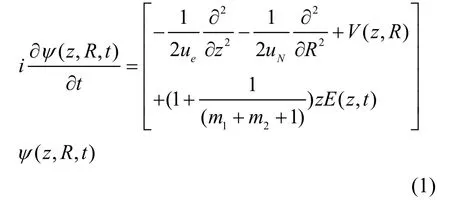
式中:m1,m2是2个核的质量。ue=(m1+m2)/(m1+m2+1),uN=m1m2/(m1+m2)是电子与核的约化质量。R、z分别为核与电子坐标。

其中,ω1,E,和τ分别为激光场的频率、振幅和脉宽。

表示空间非均匀形式。
本文采用蝴蝶型金属纳米结构,如图1所示,具体参数可参考文献[15]。z0表示激光场与坐标原点的距离。
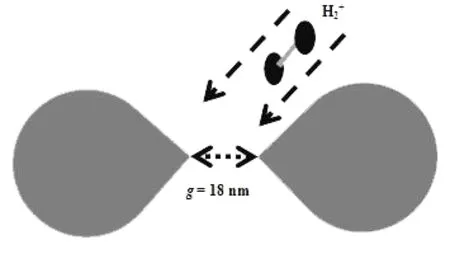
图1 蝴蝶型金属纳米结构
电离几率和解离几率(解离通道)可以表示为:

为几率流,当求电离几率时,ms=ue,s=z,s0=zs= 25 a.u.;当求解离几率时,ms=uN,s=R,s0=Rs=25 a.u.。P±d(t)为电子布局在正(P+d(t))负(P-d(t))向H核的解离通道。这里定义反对称系数A(t)=P-d(t)-P+d(t)。当A(t)>0,表示较多电子布局在负向H核;当A(t)<0,表示较多电子布局在正向H核。
2 结果与讨论
图2给出H2+在5 fs/800 nm,I=4.0×1014W/cm2空间非均匀激光场下的电离几率。由图可知,随着空间非均匀场空间位置由负向到正向移动,电离几率呈U形增大。并且随着初始振动态升高,电离几率进一步增大。但是,激光场在负向时比正向时电离几率大,即呈现反对称的特点。Yavuz等[16]研究表明,当z0为负值时,电子倾向于朝着纳米金属表面移动,因此增大了电离几率。反之,当z0为正值时,电子倾向于沿着路径返回。
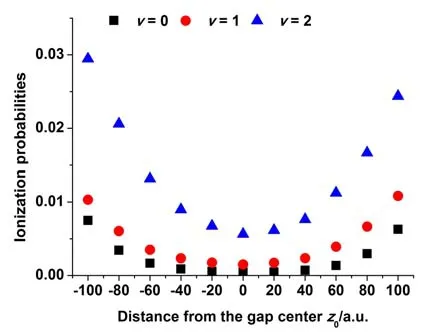
图2 H2+在空间非均匀场下的电离几率
图3给出H2+在上述激光场下的解离几率和解离通道的分布。由图可知,在低振动态下(v=0和v=1),解离几率呈U形增大[图3(a)和3(b)]。但随着振动态升高(v=2),解离几率在某一特定(|z0|>40 a.u.)位置开始减小,并呈M形分布[图3(c)]。这是因为当激光空间位置远离坐标原点后,例如:|z0|>40 a.u.,金属表面等离子共振增强非常明显,导致激光强度非线性增大[11],因此导致电子有较大几率发生电离(见图2(c)的电离几率),从而抑制了解离的发生。解离通道的电子布局分布表明,多数电子倾向于布局在负向H核。
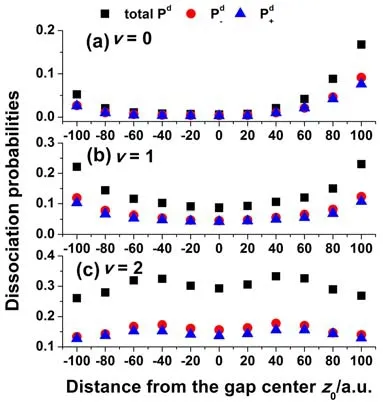
图3 H2+在空间非均匀场下的解离几率
图4给出解离通道的反对称系数A随激光场空间位置z0的变化。从图中可知,所有的反对称系数A都大于零,表明电子布局在负向H核的几率大。对于v=0的情况,最大反对称系数出现在z0=100 a.u.,其值为A+100=1.53×10-2。对于v=1的情况,反对称系数呈U形成大,其最大值为A±100= 1.6×10-2。对于v=1的情况,反对称系数也呈现类似的‘M’形分布,最大值A+40=2.2×10-2。
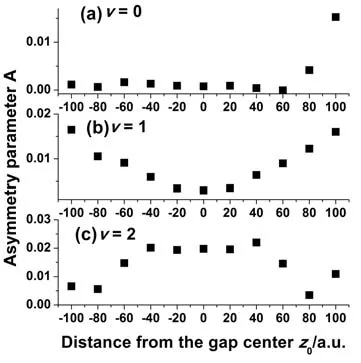
图4 H2+解离通道反对称系数A
图5[图5(a)-(c),z0=-100 a.u.;图5(d)-(f),z0= 0.0 a.u.;图5(g)-(i),z0=100 a.u.]给出H2+在上述空间非均匀场下电子波包演化图。由图可知,电子在t=2.5T时沿着正向H核发生电离,并远离核子;半个周期后,即,t=3.0T时电子在激光作用下返回核子,并沿负向H核远离核子;随着激光场再次反向,电子在t=3.5T时又一次加速沿着正向H核远离核子。并且,当空间非均匀激光场位置远离原点时,电子有更大的几率远离核子,因此导致电离几率增大。
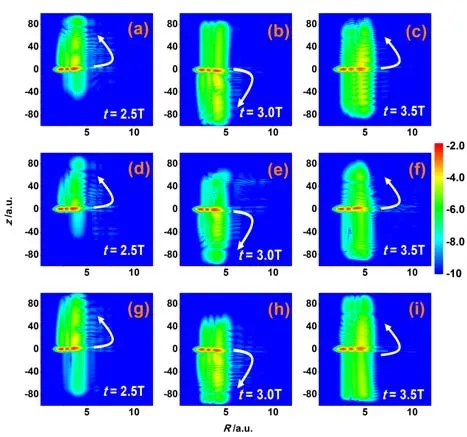
图5 H2+在空间非均匀场下电子波包演化图
3 结 论
综上所述,本文理论研究了H2+在空间非均匀场下的电离解离行为。结果表明,随着空间非均匀场空间位置由负向到正向移动,电离几率呈U形增大。并且随着初始振动态升高,电离几率进一步增大。在低振动态下,解离几率呈U形增大。但随着振动态升高,解离几率在某一特定位置开始减小,并呈M形分布。解离通道的电子布局分布表明,多数电子倾向于布局在负向H核。通过分析含时量子波包运动,给出了电子在空间非均匀场下的运动情况。
[1]Krausz F,Ivanov M.Attosecond physics[J].Rev Mod Phys, 2009,81(1):163-234.
[2]Feng L Q,Chu T S.Generation of an isolated sub-40-as pulseusingtwo-colorlaserpulses:Combinedchirp effects[J].Phys RevA,2011,84(5):053853.
[3]Uiberacker M,Uphues T,Schultze M,et al.Attosecond real-time observation of electron tunnelling in atoms[J].Nature,2007,446(7136):627-632.
[4]CorkumPB.Plasmaperspectiveonstrongfield multiphoton ionization[J].Phys Rev Lett,1993,71(13): 1994-1997.
[5]Chen Y J,Zhang B.Tracing the structure of asymmetric molecules from high-order harmonic generation[J].Phys RevA,2011,84(5):053402.
[6]Feng L Q,Chu T S,Wang L.Low-energy structure in the ionizationofargon:comparisonofexperimentwith theory[J].Chin Phys B,2013,22(2):023302.
[7]Feng L Q,Chu T S.Intensity enhancement in the molecular ionization and dissociation dynamics in the presence of noise[J].J Mol Model,2012,18:5097-5106.
[8]Bian X B,Bandrauk A D.Multichannel molecular high-order harmonic generation from asymmetric diatomic molecules[J].Phys Rev Lett,2010,105(9):093903.
[9]Bian X B,Bandrauk A D.Nonadiabatic molecular high-order harmonic generation from polar molecules: Spectral redshift[J].Phys RevA,2011,83(4):041403.
[10]Chen Y J,Zhang B.Role of excited states in the emission times of harmonics from asymmetric molecules[J].Phys RevA,2012,86(2):023415.
[11]Kim S,Jin J,Kim Y J,et al.High-harmonic generation by resonant plasmon field enhancement[J].Nature,2008, 453(7196):757-760.
[12]FengLQ.Molecularharmonicextensionand enhancement from H2+ions in the presence of spatially inhomogeneous fields[J].Phys Rev A,2015,92(5): 053832.
[13]Feng L Q,Liu H.Theoretical investigation of the asymmetricmolecularharmonicemissionandthe attosecond pulse generation[J].J.Mol.Model,2015,21(3): 43.
[14]Lu R F,Zhang P Y,Han K L.Attosecond-resolution quantum dynamics calculations for atoms and molecules in strong laser fields[J].Phys.Rev.E,2008,77(6): 066701.
[15]Xue S,Du H C,Xia Y,et al.Generation of isolated attosecond pulses in bowtie-shaped nanostructure with three-color spatially inhomogeneous fields[J].Chin.Phys.B,2015,24(5):054210.
责任编校:刘亚兵
Ionization and Dissociation Dynamics of H2+by Using Spatial Inhomogeneous Field
LIU Hang1,LIU Hui2,FENG Li-qiang2
(1.College of Chemical and Environmental Engineering,Liaoning University of Technology,Jinzhou 121000,China; 2.College of Science,Liaoning University of Technology,Jinzhou,121001,China)
Ionization and dissociation dynamics of H2+driven by spatial inhomogeneous field has been theoretically investigated.Calculated results show that as the spatial position of the inhomogeneous field is moving from the negative value to the positive value,(i)an enhancement of the ionization probability with the shape of U can be obtained.Moreover,with the increase of the initial vibrational state,the ionization probability can be further enhanced.(ii)An enhancement of dissociation probability with the shape of U can be found in the lower initial vibrational state,and a shape of near-‘M’can be obtained in the higher initial vibrational state.The electron localization of the dissociation channel shows that much more electrons prefer to localize on the negative-H.(iii)Through the investigations of the time-dependent wave function,the attosecond-resolution electron dynamics in the presence of the spatial inhomogeneous field can be shown.The present investigation is helpful to understand the molecular dynamics in the presence of the spatial inhomogeneous field.
ionization probability;dissociation probability;H2+;spatial inhomogeneous field
O562.4
A
1674-3261(2017)01-0044-04
2016-10-09
国家自然科学基金项目资助(11504151);辽宁省教育厅基金项目资助(JL201615405)
刘航(1985-),女,辽宁锦州人,讲师,博士。
10.15916/j.issn1674-3261.2017.01.012
